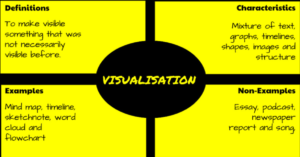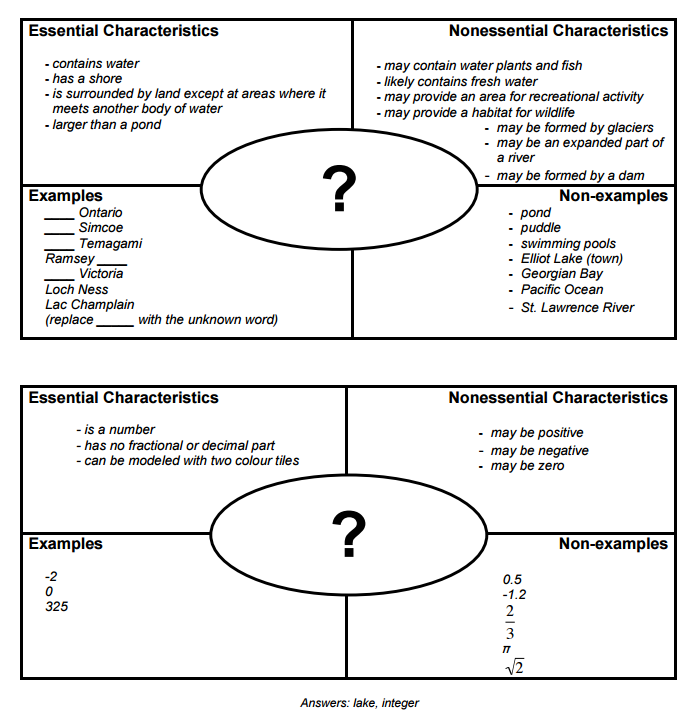 In a perfect world, vocabulary is learned in context: The phrases and sentences around the unknown word define the meaning. If that isn’t sufficient, students use affixes — prefixes, suffixes, and roots — to decode meaning. But because the world isn’t always that pristine, Dorothy Frayer and her colleagues at the University of West Virginia came up with a vocabulary teaching tool that has come to be known as “the Frayer Model”. Now used by thousands of educators, this approach to word study relies on analyzing words rather than memorizing definitions. Somewhat like Concept Circles, the Frayer Model uses a graphical organizer that asks students to describe words by much more than a memorized definition. They must:
In a perfect world, vocabulary is learned in context: The phrases and sentences around the unknown word define the meaning. If that isn’t sufficient, students use affixes — prefixes, suffixes, and roots — to decode meaning. But because the world isn’t always that pristine, Dorothy Frayer and her colleagues at the University of West Virginia came up with a vocabulary teaching tool that has come to be known as “the Frayer Model”. Now used by thousands of educators, this approach to word study relies on analyzing words rather than memorizing definitions. Somewhat like Concept Circles, the Frayer Model uses a graphical organizer that asks students to describe words by much more than a memorized definition. They must:
- define the term
- describe essential characteristics
- provide examples
- provide non-examples
Because the Frayer Model digs deeply into understanding the word, it promotes critical thinking and a granular familiarity with unfamiliar vocabulary. It draws on a student’s prior knowledge to build connections among new concepts and creates a visual reference by which students learn to compare attributes and examples.
Steps to the Frayer Model
Here’s what to do when you introduce the Frayer Model to your class:
- Explain the graphical organizer — the key term in the center bubble with details in the four segments around the middle. Those four segments may vary but will build understanding not just of the word’s definition but its purpose in conversation.
- Use a word students already know (say, “meteor” in a science class) to model how students will fill in the sections. Take any questions they have.
- When students are comfortable with the process, pass out the word list they will analyze using this Frayer graphic organizer.
- Divide the class into small groups or pairs. Assign each group one of the words and have them complete the organizer.
- Ask the student groups to share their conclusions with the entire class.
Once students have completed their first Frayer visual organizer and shared it with classmates, they can be expected to use it independently as classwork or homework.
Educational Adaptations
While the Frayer Model works well with any grade level, it is especially effective with middle and high schoolers — students who no longer think they need a unit called “vocabulary”. The detail required by the Frayer Model results in these advanced students learning not just one word, but a host of related concepts. This is particularly useful for high schoolers preparing to take the SAT/ACT tests.
The Frayer Model normatively differentiates for student needs by encouraging them to draw on their own knowledge when completing categories for “characteristics” and “examples” (or “non examples”). Because this can be done just as effectively with words or drawings, it works well for students who are better at showing their thoughts than telling them in narrative.
Feel free to reframe any of the cells to suit student needs or class inquiry. I’ve seen Frayer Models that don’t even include a definition (see image below), relying instead on characteristics or a picture to communicate meaning. Any categories work that end up in a deep understanding of the word.
Use the Frayer Model in secondary language classes to gain a multi-layered appreciation of the word being discussed by writing everything in the second language. This is a good opportunity to include a student-drawn image in place of one of the boxes.
Update this exercise by distributing the template as a PDF through your school LMS, Google Classroom, or MS Classroom (or OneNote’s Classroom add-on). Students fill it in with their native PDF annotator (or a stylus if that’s available) and when finished share as a screenshot or a link. This saves paper shuffling, minimizes time required to pass out and collect worksheets, and allows students to complete it at their own pace (within classroom constraints, of course).
Storyboard That!, a digital storytelling comic-creator tool, offers a Frayer Model template where students fill each section in with the comic-style images, backgrounds, and text provided by the site, ending up with an appealing kid-friendly decoding of the word they’re studying:
Instead of giving students the word and asking them to fill in the bubbles, complete the bubbles but leave the middle word blank and ask students what word has been described. You can make this a game, working as a class or in small groups to see who gets the most right answers. Here are two examples from the Ontario (Canada) Association for Mathematics Education:
The Frayer Model takes learning vocabulary beyond memorization into thinking critically, making connections, and understanding concepts. This is well-suited to teaching academic vocabulary for all and domain-specific for particular topics (such as math).
— Image credit: Aaron Davis
Jacqui Murray has been teaching K-18 technology for 30 years. She is the editor/author of over a hundred tech ed resources including a K-12 technology curriculum, K-8 keyboard curriculum, K-8 Digital Citizenship curriculum. She is an adjunct professor in tech ed, Master Teacher, webmaster for four blogs, an Amazon Vine Voice, CSTA presentation reviewer, freelance journalist on tech ed topics, contributor to NEA Today, and author of the tech thrillers, To Hunt a Sub and Twenty-four Days. You can find her resources at Structured Learning.




















































































































